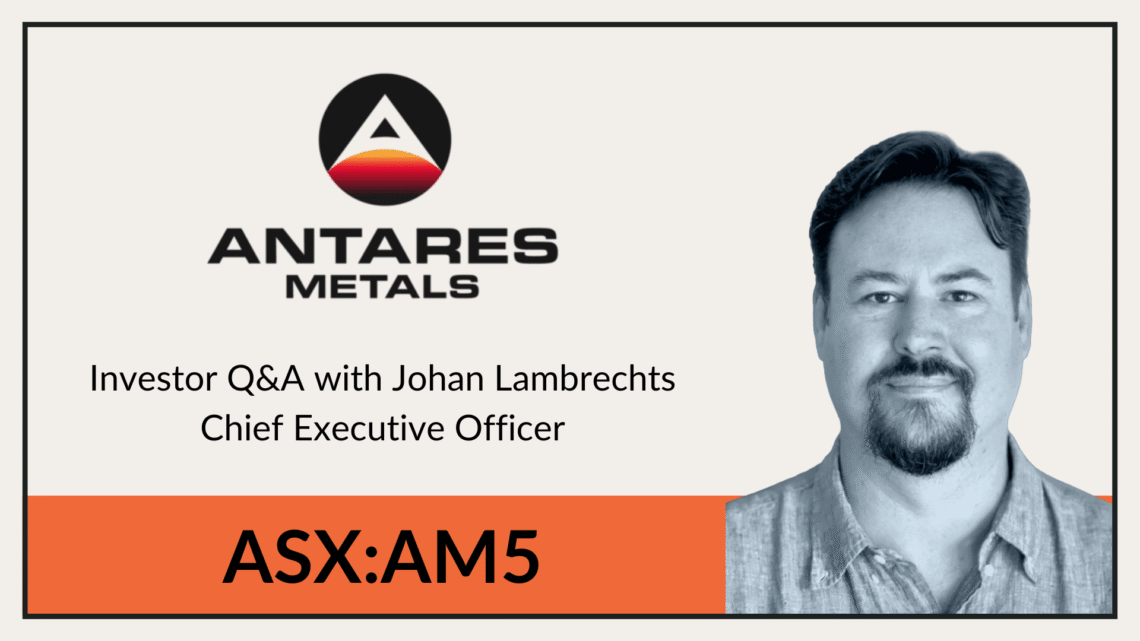
Antares Metals (ASX:AM5) confirms expansion of high-grade copper at Cromwell discovery
October 30, 2025 Off By MarketOpenAntares Metals Ltd (ASX:AM5) has released additional high-grade copper results from its Cromwell discovery within the Mount Isa North Project, confirming the continuity of mineralisation across multiple veins and extending the system’s footprint.
The latest assays have returned grades of up to 20.5% copper from the newly tested “D” vein, extending mineralisation eastward from the main “A” vein, which previously produced grades of up to22.5% copper.
With copper-bearing veins now traced over a nine-kilometre strike length, the Cromwell prospect continues to demonstrate strong geological continuity and open-ended potential.
Chief Executive Officer Johan Lambrechts discusses the latest results, the geological context of the discovery, and the company’s strategy for advancing exploration across its highly prospective Mount Isa North Project.
What do the latest results from the Cromwell discovery reveal about the project’s scale and potential?
The latest assay results have further confirmed the strength and continuity of the Cromwell copper system.
The new set of fifteen rock chip samples returned copper grades of up to 20.5%, reinforcing earlier results and confirming the consistency of high-grade mineralisation across the area.
In total, 96 samples have been collected, with 40 returning copper grades above 1%, demonstrating a robust and extensive mineralised system.
The mineralisation extends along a nine-kilometre corridor that remains open in all directions, with widths reaching up to thirty metres in some areas.
Multiple copper-bearing quartz-carbonate veins, each up to three metres wide, combine in places to form broader mineralised zones. According to Johan Lambrechts, the strong grades and geological footprint provide a compelling basis for continued exploration.
“The Cromwell discovery is shaping up to be a very exciting prospect, which the Company plans to explore much further in the coming months.”
What is the significance of discovering copper mineralisation in the “D” vein, and how does it extend the prospect?
The identification of the “D” vein represents a major step forward in expanding the mineralised footprint at Cromwell. The new structure lies about nine hundred metres east of the main “A” vein and has been mapped for approximately two hundred metres before going beneath shallow cover.
Within that zone, copper oxides are visible across the outcrop, and sampling confirms that mineralisation continues beyond what is currently exposed.
One of the standout samples from this zone recorded 20.5% copper, 0.19 grams per tonne gold, and 3.15 grams per tonne silver, collected from a vuggy quartz vein containing malachite and chrysocolla.
Several other samples from the same area returned grades above 1% copper, supporting the interpretation that high-grade mineralisation occurs within multiple vein systems at Cromwell.
The discovery of the “D” vein shows that mineralisation is not restricted to one structural feature but rather extends through a network of shear-hosted veins that collectively enhance the project’s scale and potential.
“We’ll endeavour to identify mineral-concentration hotspots through ground and geophysical surveys to generate the first drill targets on the Cromwell prospect.”
Can you explain the geological characteristics of the Cromwell prospect and how they compare to known deposits in the Mount Isa region?
Cromwell sits within one of the world’s most significant copper provinces, and its geological characteristics closely align with the mineralisation styles that define the Mount Isa region.
The copper mineralisation is hosted within shear-related quartz-carbonate veins, while the surrounding host rocks are also mineralised.
These rocks are mosty the metabasalts of the Cromwell metabasalt suite as well as dolorite on occasion. In some areas, the combined mineralised zone reaches widths of up to thirty metres.
This style of mineralisation is typical of shear-hosted copper systems found across the Mount Isa district, where copper-bearing fluids migrate along structural zones and deposit mineralisation as they interact with reactive host rocks.
The similarities between Cromwell and other known regional systems confirm that the project sits within the same proven metallogenic environment, underscoring its exploration significance within the broader Mount Isa North Project.
What are the next steps for Antares at the Cromwell prospect and across the Mount Isa North Project?
The immediate focus is to identify the most prospective zones for the next stage of exploration.
Antares plans to undertake a series of geophysical surveys, including airborne gravity and magnetics as well as detailed electrical surveys, to pinpoint mineral traps or higher-grade copper zones beneath surface cover.
At the same time, the company will continue field mapping and sampling across the nine-kilometre strike length to refine its geological model and improve its understanding of mineralisation controls.
Once the geophysical and surface data are integrated, the company expects to generate and prioritise its first drill targets at Cromwell.
In parallel, Antares Metals is also reviewing and ranking additional prospects across theMount Isa North Project, ensuring a methodical approach to exploration across its entire portfolio.
“The combination of the Conglomerate Creek and Cromwell discoveries during our first exploration season on this ground gives AM5 a strong foundation for value creation for the remainder of the year and into 2026.”
How do the Cromwell and Clonglomorate Creek discoveries position Antares Metals for future growth?
The Cromwell and Conglomerate Creek prospects together provide Antares with a strong foundation in a world-class copper district.
Both discoveries were made during the company’s first exploration season, which reflects the quality of the ground and the effectiveness of its exploration strategy.
Cromwell has now delivered copper assays up to 22.5% from the “A” vein and 20.5% from the “D” vein, while Conglomerate Creek has shown complementary mineralisation nearby.
Together, these prospects form a pipeline of high-potential copper targets that will continue to be advanced through systematic exploration.
As the company moves into 2026, it will maintain its focus on integrating geophysics, mapping, and drilling to expand its understanding of these systems and drive long-term exploration value across the Mount Isa North Project.
Building momentum through systematic exploration
The Cromwell discovery continues to deliver strong high-grade copper results across multiple vein systems, confirming the presence of a large, shear-hosted mineralised corridor within one of Queensland’s most prospective geological belts.
Together with the nearby Conglomerate Creek discovery, Cromwell forms the cornerstone of Antares Metals’ exploration program.
As Chief Executive Officer Johan Lambrechts explains, the next phase of work will integrate field data with modern geophysical techniques to define priority drill targets and establish the foundation for future exploration success.
These programs will guide the company’s first round of drilling at Cromwell and mark the next step toward unlocking the broader potential of the Mount Isa North Project.
Please note the following valuable information before using this website.
Independent Research
Market Open Australia is intended to be used only for educational and informative purposes, and any information on this website should not be taken as investment advice or guidance. It is important to conduct your own research before making any investment decisions, which should be based on your own investment needs and personal circumstances. Any investment decisions based on information contained on this website should be taken in line with independent financial advice from a qualified professional or should be independently researched and verified.


